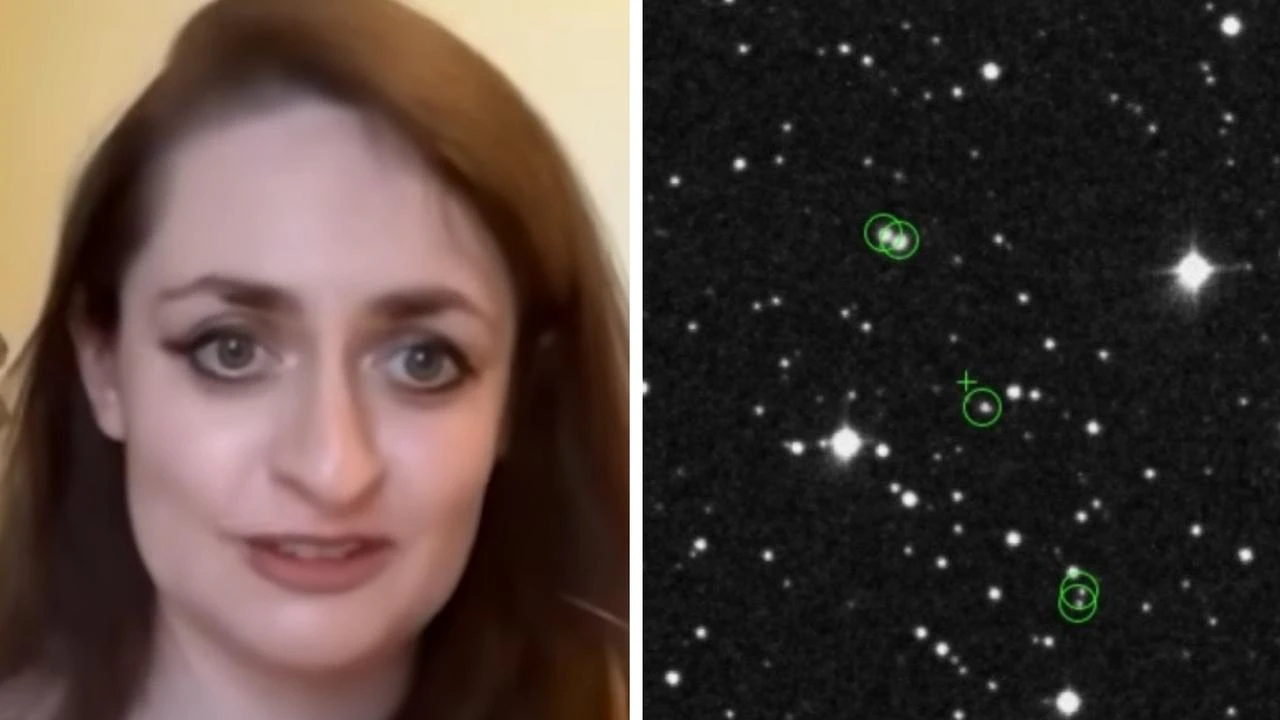Copyright news

Researchers from Nordita (The Nordic Institute for Theoretical Physics) at Stockholm University in Sweden, together with colleagues from Vanderbilt University in the United States, have published two new studies analysing so-called transients in photographic plates from the early 1950s. The studies, which have sparked widespread buzz among UFO/UAP enthusiasts, purport to show unexpected patterns in a small number of these flashes of light that can’t be explained away simply as asteroids or defects in the plates. Dr Beatriz Villarroel, who leads the VASCO project (Vanishing and Appearing Sources During a Century of Observations) at Nordita, said today “we know that short flashes of light are often solar reflections from flat, highly reflective objects in orbit around the Earth, such as satellites and space debris”. “But the photographic plates analysed in VASCO were taken before humans had satellites in space,” she said in a statement. The VASCO project analyses digitised astronomical plates to identify sources that blink, disappear or suddenly appear. The first paper, published in the journal Scientific Reports, analysed more than 106,000 flashes of light and showed statistical connections between the times phenomena appeared and reports of UAP or nuclear weapons tests during the 1950s. Between 1951 until the launch of Sputnik in 1957, at least 124 above-ground nuclear tests were conducted by the US, UK and the Soviet Union. UAP witness report data was taken from the UFOCAT database maintained by the Center for UFO Studies, the most comprehensive publicly available UAP sighting database covering the 1949-1957 period that originated with the US Air Force funded-University of Colorado UFO study led by Dr Edward Condon. Cross-referencing the data, the researchers found the flashes were 68 per cent more likely to occur the day after a nuclear weapons test than on days without, while the number of flashes increased by an average of 8.5 per cent for each report of UAP. When reports of UAP and nuclear tests coincided, the effects were additive, with more than twice as many flashes of light as on days without either nuclear tests or reports. “The magnitude of the association between these flashes of light and nuclear tests was surprising, as was the very specific time at which they most often occurred — namely, the day after a test,” said lead author Dr Stephen Bruehl from Vanderbilt University. “What they might represent is a very fascinating question that needs further investigation.” In the paper, the authors hypothesised that “some transients might represent an unrecognised atmospheric effect of nuclear testing”. “Alternatively, it is also possible that fallout from nuclear testing may itself cause direct contamination of astronomical photographic plates, with a characteristic appearance of fogged spots noted on X-ray sensitive photographic film,” they wrote. The second paper, published in Publications of the Astronomical Society of the Pacific (PASP), specifically looked for instances where flashes of light appeared along a line or narrow band — indicating reflections from flat, reflective objects in motion. “This approach follows the principle of seeking non-terrestrial artefacts (NTAs) via distinctive, low-probability observational signatures, or ‘smoking gun indicators’,” the authors wrote. They identified five potential candidates, most notably one which occurred on July 27, 1952, the same night as the infamous “UFO flap” in Washington, DC. “Finding such objects in pre-Sputnik data would represent a significant discovery with far-reaching implications for both astronomy and humanity, including the possibility of NTAs,” the authors wrote. “It also bears directly on the scientific investigation of unidentified anomalous phenomena (UAPs), formerly known as unidentified flying objects (UFOs) — a subject that, after decades of stigma, is now gaining serious academic attention.” The same article, which again studied the more than 106,000 apparent flashes of light in the astronomical plates, compared how often the phenomena occur in the earth’s shadow, where solar reflections cannot occur. Their analysis found one-third of the flashes were missing in the earth’s shadow, suggesting that at least one-third of the phenomena were caused by solar reflections from highly reflective objects in high orbits. “Amidst what has been perceived as noise on the plates, there seems to be a genuine population of phenomena that correlate with, among other things, nuclear weapons tests or reports of UAP and that are missing in the earth’s shadow,” said Dr Villarroel. “You don’t get [those] kind of solar reflections from round objects like asteroids or dust grains in space, which leave streaks during a 50-minute exposure, but only if something is very flat and very reflective and reflects the sunlight with a short flash.” Other experts have poured cold water on the findings, however. “It’s not aliens,” said Michael Brown, Associate Professor in Astronomy at Monash University. “It is flaws in photographic plates taken over half a century ago. I’m extremely sceptical [of the findings]. These old photographic plates have a lot of flaws in the old emulsions, and yes those flaws can sometimes look like objects.” Prof Brown noted that Dr Nigel Hambly, Senior Researcher at The University of Edinburgh’s School of Physics and Astronomy, had recently examined similar claims by the group about the apparent flashes of light and found “the vast majority were almost certainly not real”. Dr Hambly’s analysis of the same data set, published in the journal RAS Techniques and Instruments last February, found the “putative transients are likely to be spurious artefacts of the photographic emulsion”. “We suggest a possible cause of the appearance of these images as resulting from the copying procedure employed to disseminate glass copy survey atlas sets in the era before large-scale digitisation programs,” the paper said. Prof Brown said it was also a “red flag” and “definitely a reason for caution” that the lead author on one of the papers, Dr Bruehl, was a medical doctor and not an astronomer. “People outside of fields can do significant and good work but also at the same time people who are coming at a problem from outside their field of expertise are more likely to have errors and flaws in their work as well,” he said. “But that’s a weaker argument than the fact that Hambly and Blair looked at some of these transients in an earlier work and found mostly plate flaws.” Professor Tim Bedding from the University of Sydney’s School of Physics said the results from analysing the old photographic plates “are potentially interesting”. “However, we have to remember that these photographs contain millions of stars and, if you look at enough photos, you are bound to find some unusual things,” he said in an email. “Whether these are real objects in space or simply chemical flaws in the photographic emulsion is hard to say, and it is possible that some of them come from real astrophysical objects such as flaring stars. Without better evidence, it is important not to jump to any conclusions about extraterrestrial artefacts.” Jonti Horner, Professor of Astrophysics at the University of Southern Queensland, urged that “extraordinary claims require extraordinary evidence”. Stressing that he had not had time to carefully analyse the researchers’ findings, Prof Horner said there was a “long and spectacular history of things being observed that were unexplained for long periods of time, up until you get the right person with the right expertise — then suddenly everything becomes clear”. “Sometimes it’s human, sometimes it’s a top-secret military experiment that comes out a few years later,” he said. “If I had to bet, I suspect this is going to be one of those cases — it’s a recurring theme. Here’s something really interesting that has been observed that the people doing the study can’t explain. They come up with some possible suggestions for a cause — but stop short, quite rightly, of offering a definite explanation.” Prof Horner cited the example of sightings of triangles over Yorkshire, UK when he was a child — which later turned out to be test flights of the F-117 Nighthawk US stealth bomber, first unveiled to the public in 1988 — or mysterious “sprites” seen by pilots over energetic thunderstorms, once “poo poohed” but now an active area of scientific study. “It’ll be really interesting to see what other researchers make of these results as they dig in to them more, and to see what other explanations people come up with,” he said. “I think by far the most likely result will be that astronomers will find another explanation for the results that fits the data really well, without requiring aliens.” But he said he understood the “buzz and the excitement that this has generated — anything to do with UAP always gets people excited”. “I actually think [the UAP topic] is really exciting,” he said. “One of the reasons I was really positive about the declassification of [US government] documents a few years ago was that when people see something weird in the sky they should be able to talk about it. By getting rid of this stigma about reporting and discussing this stuff, it means the data gets out there.” Dr Villarroel, speaking to The Sol Foundation YouTube channel last week, said the correlations identified in the papers — to UAP sightings, nuclear bomb tests and the earth’s shadow — defied the “plate defect hypothesis”. “Our best cases happened to be during the Washington 1952 flap,” she said. “If you have a temporal correlation it’s not going to agree with the notion that the entire sample are plate defects.” She added, “If you have asteroids it would be streaks. The only thing we know today that [have] the kind of signatures that we see in the sky today are high-orbit satellites and space debris, because they are very flat, they are highly reflective. Imagine a mirror or something really flat in a high orbit. Sometimes these things produce these kind of short flashes of light … and then you see something that looks like a point source.” Dr Villarroel also explained the “significance” of identifying flashes of light in a line. “Sometimes you can see an object, as it orbits it’s going to be rotating and tumbling and you get flashes that are on a line or along an arc,” she said. “These things are good signatures, so if you want to test the hypothesis that you have an alien artefact and you think, OK … how do I separate between contamination and real reflection, then you go and look for things that are on a line.”



